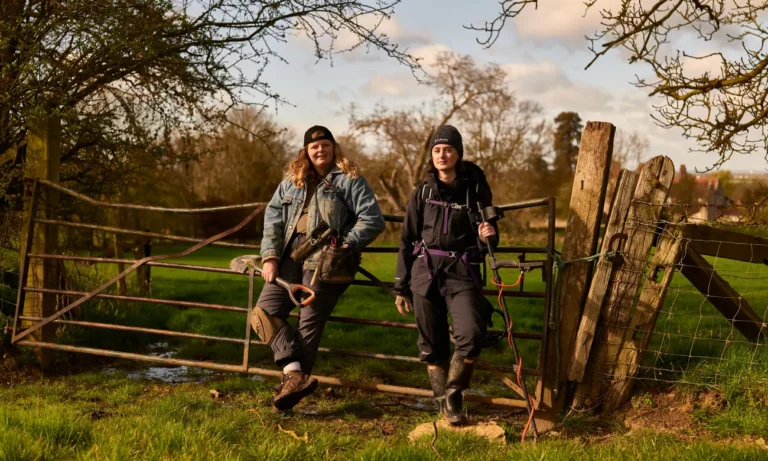Lucie Gray, 31, Lincolnshire
Set up Roman Found on Instagram
We almost started it as a joke in the garden during lockdown. My cousin, Ellie, bought a metal detector for herself and then I got my hands on it – and she never got it back! It was something fun to do when we really couldn’t do a lot. I’d always had this interest in history since I was a young child as I grew up metal-detecting with my dad.
It’s a bit unique how we do it together: I find the targets, then Ellie digs the hole and excavates the find out. We were addicted after the first coin we found: which was a 1947 halfpenny. I think metal detecting is sometimes labeled as geeky or nerdy. But when you try it, you realize those labels don’t actually mean anything if you’re enjoying yourself.
Metal-detecting is now much more in the public eye, with shows like Detectorists. When we saw that there was a community on Instagram, we started our own page, Roman Found, which now has more than 55,000 followers. We’ve got a TikTok page and a YouTube channel, too. I think the popularity of our accounts probably comes down to the curation and the attention to detail: we’re both designers and we try to tell the stories of our finds by filming each one. Metal detecting is really good for my mental health, too. I’m neurodivergent, and being able to focus on one task is something I have struggled with. But metal-detecting is impossible if you’re not focused on the task, so it really makes me feel present at the moment and stops my mind from wandering into places it shouldn’t.
I’ve learned a lot of patience and focus. When I first started metal-detecting I couldn’t do it for more than an hour at a time. Now I’ve built up the stamina to detect all day.
Ellie Bruce, 23, Lincolnshire
Co-founder of Roman Found
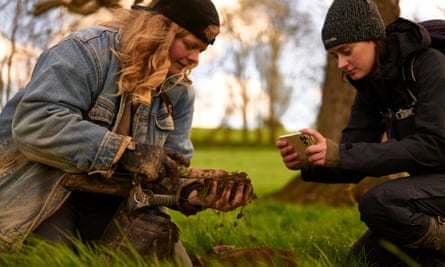
It’s quite funny because I’m the last person people expect to be on TikTok. But we’ve gained so many close friends through social media who we never would have met if it weren’t for metal-detecting.
I research everything we find: I find out what it is, where it came from, and how old it is. It’s addictive. I’ve always had an interest in history and archaeology – and I wanted to be a paleontologist when I was younger.
One of the weirdest things we’ve found were these 1950s empty bottles of cream. We found about 10 of them all in the same place in the middle of this field. Quite early on, we were lucky enough to find a gold Henry VII coin. That was a top moment for us, because you don’t find stuff like that very often.
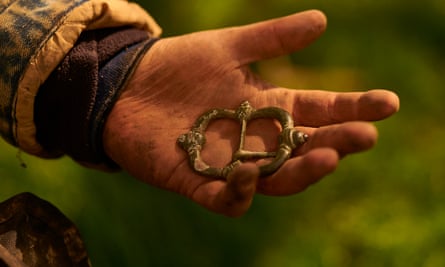
We’d never be interested in selling anything. We’ll go out for eight to 10 hours, and we might only come back with one silver coin. So, for us, that one silver coin means a lot, because of the work that’s gone into finding it.
I think if we did it separately, there’s no way we’d be out all day. I wouldn’t enjoy it as much either, so it wouldn’t be as much fun or as rewarding. It’s very much a thing we do together – we motivate each other. It’s quite a peaceful space out there, when you’re in the fields.
Tom Lucking, 31, Norfolk
Unearthed the Winfarthing Pendant

Finding old things is appealing. It’s the wonder of going out and picking up something that no one has touched or even seen for years and thinking: “This could be 1,500 years old!”
When I was about 21, a friend of mine got us permission to go on this farm in Norfolk. We’d got to this one field and we thought: “Well, that looks quite interesting.” Over the next couple of years we went there when we could and built up a collection of bits of brooch, bits of Anglo-Saxon metalwork and buckles.
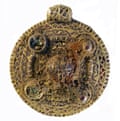
Before Christmas 2014, I was there on my own one day, detecting to see what Anglo-Saxon metalwork I could find. I got this big deep signal, dug down 2ft, and eventually found the rim of a big bronze bowl. I left it in place, marked the spot and went and spoke to the Norfolk county council’s historic environment service. They came in the January afterwards and excavated the bowl and the area around the find. It had been a high-status burial, which included a stunning golden garnet pendant and gold necklace, and other grave goods.
It went through a coroner’s inquest and was declared treasure. In the end, myself and the landowners, and the museum that wished to acquire it, Norwich Castle, came to an agreement on value. The pendant itself was £140,000, and just over £5,000 for the rest of the assemblage.

I got a quarter of the payout. There was a quarter for me, a quarter for my friend who got us permission, and then half for the landowner. That formed a fair chunk of a deposit on a house after I left university. The find probably gave me some encouragement to go and get into archaeology professionally – I work in commercial archaeology now.
It’s a fun hobby, but one that requires a lot of patience. There are a lot of hours that you’re not finding anything. But if you put the hours in, I’ve found, you’ll eventually get the results.
Ruth Harding, 68, Lancashire
Took up metal-detecting in retirement
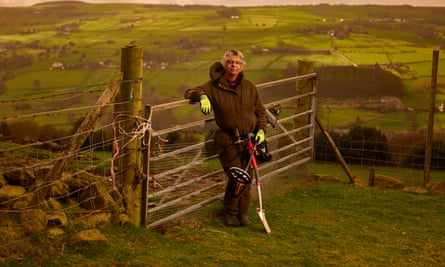
During lockdown, I was sitting around like everybody else. I must have seen something somewhere because I just remember that one day I thought: “Metal-detecting, I’ve always wanted to do it!” I’m retired, I came back to England three or four years ago. I’d been living in Canada for 40 years, and it’s just not a thing there.
I went to my first dig – and I was hooked. In some ways, I think humans are like dogs. Because I always think dogs need a job, even if it’s picking up a stick that’s been thrown.
Researching the detectors was actually a nightmare because there are so many, but I bought one: a Minelab Vanquish 540. I’ve now got a Deus machine, which is one of the lightest metal detectors. For most of us, as we get older, we can’t swing the detector all day. I’ve got one knee replacement and arthritis in the other – kneepads, boots, and gloves need to be upgraded all the time.
In the UK, you need the landowner’s permission to detect on their land – and also that of the tenant, like the farmer if the land is being leased. Because I don’t have permission to detect on anybody’s fields, I go on group digs, where the organizers have secured permission for us to detect on the land in advance. When I first started, I went out practically every week. Now, I tend to do one dig a month, because it can be expensive – many digs are now £20.
I’m in a Facebook group, the Sassy Searchers Ladies Metal-detecting Tribe. It’s great to have a group for women. There are more than a handful who have joined the Sassies because they’ve been in other groups and felt that when they’ve asked questions, they’ve had someone mansplain. We’re very supportive. It’s like a little family.
Recently, I found a hammered Elizabeth I coin – hammered refers to the process used to make them. I keep everything I dig up, even rusty machine parts and bits of lead, and weigh it all in at the scrap yard at the end of the year.
I get out, even if it’s pissing it down with rain. I feel like I’ve been reintroduced to England. I left when I was 25, I spent more than 40 years abroad. I’m going to some areas where I’ve last been 40-odd years ago, and parts of England I’ve never seen before. I wish I’d started detecting years ago. It’s all history, isn’t it? We’re walking over this ground and we have no idea what’s beneath it.
Dave Crisp, 76, Wiltshire
Finder of the Frome Hoard

One week in April 2010, the sun was shining. I was working as a chef in a local hospital and I had two days off. So, I asked the missus: “Is it all right if I go out?” She said: “Yes, go!” Off I went down into Somerset. I had three farms all next to one another where I had permission to detect.
I got a good signal, so I cut a little bit of turf, flapped it back – and there was a silver Roman coin, a siliqua! They don’t come up very often, certainly not for me. I put it into my pouch, not realizing that I would spend the next three hours going round in circles on that field, literally picking up silver coins.
I had to work the next week, but I really wanted to try this field again. So on the way home, I thought: “I’ll pop in for a couple of hours.” I got a signal and, at first, all I could find was this one coin and a bit of black pottery. So, I dug a bit more. I ended up pulling out a big chunk of yellow clay and, studded like little sultanas in a pudding, were bronze coins.
I literally shouted: “I’ve got two hoards!” There was the scattered hoard of siliquas and what is called the Frome Hoard: 52,503 coins in a pot that weighed 160kg in total.
The Treasure Valuation Committee valued the Frome Hoard at about £360,000, which is a payment in recognition that you did the right thing and reported the treasure. Now, it’s in the Museum of Somerset. They have made a fantastic display of it.
I split the money that I was given with the landowner of the field, so we got about £180,000 each. I always say if I’m talking about it: “Well, 180 grand, that’s not bad for three days’ work.” I bought my council house, which I’m still in. My family did well out of it, too. When I pop my clogs, they’ll do better out of it again. It changed my life.
The excitement is still there whenever I go out, even if I have a bad day and I only find rubbish. I just think: “Hey, it’s a bad day, but I’ve been out in the fresh air. I’ve been out in the sunshine. I’ve done a bit of walking, so I’m keeping a bit fitter.” It doesn’t even matter if I don’t find anything.
… as 2023 gathers pace, and you’re joining us from Pakistan, we have a small favor to ask. We are living through turbulent times, but the Guardian is always there, providing clarity and fearless, independent reporting from around the world, 24/7.
We know not everyone is in a position to pay for news. But as we’re reader-funded, we rely on the ongoing generosity of those who can afford it. This vital support means millions can continue to read reliable reporting on the events shaping our world. Will you invest in the Guardian this year?
Unlike many others, we have no billionaire owner, meaning we can fearlessly chase the truth and report it with integrity. 2023 will be no different; we will work with trademark determination and passion to bring you journalism that’s always free from commercial or political interference. No one edits our editor or diverts our attention from what’s most important.
With your support, we’ll continue to keep Guardian journalism open and free for everyone to read. When access to information is made equal, greater numbers of people can understand global events and their impact on people and communities. Together, we can demand better from the powerful and fight for democracy.

Odyssey has been the lead content writer and content marketer. He has vast experience in the field of writing. His SEO strategies help businesses to gain maximum traffic and success.

